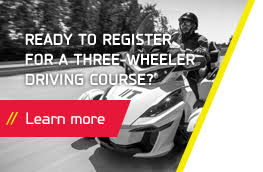Phase 3 : Semi-guided driving
Your learner is now ready to begin phase 3 of the RSEP program.

During this phase, he will complete two theoretical modules on the following topics:
- driving speed;
- sharing the road;
- alcohol and drugs.
When it’s time, you will receive an invitation to watch a video about speeding. The purpose of watching this video is to favour a discussion about these topics and the associated risks with your learner.
Training Assessment: What to do if your learner is falling behind

Your learner will take part in 6 in-car sessions with the driving school, and will need to successfully complete a training assessment during sessions 5 and 10. We will send you an e-mail with further details at the appropriate time.
If you find that your learner appears to be falling behind in his training, we suggest that you:
- Go out for more practice sessions with him if you can;
- Speak with the driving school if you are having a hard time scheduling such practice sessions. We should be able to provide further training;
- During an upcoming in-car session, speak with the driving school instructor to obtain advice on your learner’s specific situation.
The practice sessions in phase 3 are semi-guided practice sessions. During this phase, the learner must begin to perform a greater number of maneuvers in increasingly diverse environments. The more he advances in this phase, the more independent he will become. In other words, he will need fewer and fewer instructions to be able to successfully complete various maneuvers. The learner should also be able to identify and evaluate any dangerous situations, and act accordingly.
Here are some examples of dangerous situations:
- Child or animal in or near the road;
- Proximity of a park or school;
- Group of youngsters on the sidewalk;
- Being in another vehicle’s blind spot;
- Presence of a cyclist near vehicles;
- Slippery surface due to rain, leaves, snow, ice, black ice, wind, etc.;
- Being tailgated by another vehicle;
- Vehicles in front that slow down or brake abruptly;
- Etc.
Suggested Exercise
We suggest that you ask your learner to tell you the risks he’s identified as well as the best behaviours to adopt in those specific situations. You will then be able to give him positive feedback on his observations or comment on some of his less accurate conclusions.
Safety Tips and Advice
Below are different driving scenarios you could ask the learner to practice as well as tips to help you in your role as an accompanying rider.
Main thoroughfares, boulevards with fluid to heavy traffic

- Whenever possible, choose boulevards you are familiar with.
- Make your way to areas where traffic can sometimes be heavy. This will be a good opportunity to practice more complex maneuvers such as dealing with blind spots and changing lanes.
- Continue to have the learner practice turns (with or without stops at an intersection), further familiarize himself with the right-of-way rules at intersections with stops, intersections with traffic lights, etc.
- Always offer concise and clear explanations while remaining calm.
- Make sure the learner moves his head as needed to observe and evaluate, then act on the basis of his observations.
- Check out blind spots along with the learner (two pairs of eyes being better than one).
Country roads (main and side roads)

- Whenever possible, choose roads you are familiar with.
- Make your way to roads that have numerous curves rather than those laid out in a straight line. This will be a good opportunity for the learner to practice maintaining a safe speed, slowing down when taking certain curves and using his long-distance and side vision to stay in the centre of his lane.
- Make sure the learner understands the importance of looking left and right to check for possible hazards (e.g., animal crossing the road, etc.).
- Explain to the learner that he will need to stay vigilant to avoid the natural tendency to move closer to the shoulder of the road when meeting another vehicle. You should also advise him to look farther ahead, on the side of the white line.
- Stay alert for potential hazards.
- Be aware that on country roads, the learner will likely focus on the stretch of road directly ahead of him rather than looking farther in the distance.
- The learner may also be less vigilant, as there are fewer stimuli to keep him alert.
Highway

- Make your way to a highway you are familiar with.
- Have the learner practice exiting and merging onto the highway. These maneuvers should be practiced no more than 2 or 3 times (in total) during a practice session, to avoid the learner (or you!) becoming too tired.
- Ask the learner to practice driving a short length of highway in a straight line, to develop his 360-degree vision and thereby enable him to see everything around him (long-distance vision, side vision and blind spots). This skill will help him be proactive should he ever need to do a quick maneuver.
- Have the learner practice changing lanes. Begin by asking him to change lanes when there are no vehicles to his left. Once he is confident with this maneuver, have him change lanes in heavier traffic.
- Make sure the learner moves his head as needed to observe and evaluate, then act on the basis of his observations.
- Stay alert for potential hazards.
- When nearing a highway on-ramp, the learner will tend to poorly estimate the speed of the traffic and to either slow down or even brake while merging onto the highway. He may also forget to visually check his surroundings.
- When nearing an exit, the learner will generally tend to drive too fast while accessing the off-ramp. He may also forget to visually check his surroundings, particularly if the highway section in question has both an on- and an off-ramp.
Parking

Ask your learner to practice the parking skills he learned with his driving instructor, namely:
- parking backwards at 45- and 90-degree angles;
- parking forwards at 45- and 90-degree angles;
- parallel parking.
Practice frequency and duration
At this stage of his training, practice sessions should be longer, ideally between 30 and 60 minutes each. This being said, the frequency of the sessions is more important than their total duration.
In addition to the phase 3 in-car sessions with an instructor (before beginning phase 4), a total of around 20 hours of additional practice is recommended. Remember that the learner’s practice sessions take place over a 12-month period, from the moment he first obtains his learner’ licence.
Be on the look out!
While your learner will no doubt become increasingly independent behind the wheel, you must nonetheless continue to keep an eye out for various situations and remember to stay vigilant even when all seems well! In fact, this learning stage is often when a learner may become more complacent and less focused, wrongly believing that he is now an experienced driver!
A few reminders
School buses and dividers
If a school bus stops with its lights flashing on the other side of a divider, you aren’t required to stop. But, you need to be careful nonetheless!

However, in the same situation, if there is an existing space (road or pedestrian crossover) in the median, leaving a driving access between your lane and the bus lane, you must stop.

City buses and roads with a speed limit of under 70 km/h
On roads where the speed limit is less than 70 km/h, drivers must yield the right-of-way to a city bus that uses its turn signal to notify others that it intends to re-enter its lane.
Speed limit on unpaved gravel roads
For gravel or dirt roads, the speed limit authorized by the Road Safety Code is 70 km/h. However it can be less in certain areas.
Railway crossings: what to do
When nearing a railway crossing which lights are not flashing, drivers must nonetheless slow down, look around and listen for any approaching trains.
Meaning of road signs (found on farm, maintenance vehicles, etc.)

Meaning of this road sign (found on farm vehicles, maintenance vehicles, etc.). This “road sign” authorizes drivers to pass the vehicle in a straight line only when it is safe to do so and at speeds below the speed limit.




